(Press-News.org) CHICAGO – A new study, published in the July, 2014, issue of the Journal of the National Cancer Institute by Northwestern Medicine® researchers, sheds new light on the risks associated with the growing popularity of endoscopic resection in the treatment of localized, early-stage esophageal cancer. Researchers found that the more traditional surgical resection, while more invasive, provided significantly better outcomes with an 87.6 percent five-year survival rate for patients than endoscopic resection, which had a 76 percent five-year survival rate. The study, "Treatment Trends, Risk of Lymph Node Metastasis, and Outcomes for Localized Esophageal Cancer," reviewed the outcomes of more than 5,000 patients from 824 hospitals using the National Cancer Data Base, a program of the American College of Surgeons Commission on Cancer and the American Cancer Society.
Endoscopic esophageal resection uses an endoscope, a flexible tube equipped with a small camera, which can be guided to very specific locations within the gastrointestinal tract with little or no disruption to the rest of the body. Esophageal surgical resection is used to remove a section of a patient's esophagus, and the digestive tract is then reconstructed by reconnecting the remaining unaffected sections.
"Endoscopic resection was becoming a more and more common surgical choice for treating early-stage esophageal cancer, but there really wasn't a single large study with evidence to suggest it was the best choice," said the senior author of the study, David J. Bentrem, MD, director of the Gastrointestinal Oncology Lab at Northwestern Memorial Hospital and Method professor of surgical research for the Northwestern University Feinberg School of Medicine. "This study sheds some much needed light on the issue and will hopefully encourage physicians and patients to more closely examine whether or not endoscopic resection is the best course of treatment."
In addition to reviewing survival rates, the study found that despite the lack of strong evidence-based research to promote a growing use of endoscopic esophageal resection, the procedure increased from 19 percent in 2004 to 53 percent in 2010 for T1a cancers and from 6.6 percent in 2004 to 20.9 percent in 2010 for T1b cancers. While both stages of esophageal cancer involve tumors that are close to the surface and relatively small, T1a esophageal tumors are the closer to the surface and less mature than those classified as T1b. The study's authors also state that most likely due to these differences, they also found that roughly one in five T1b cancers had spread to at least one lymph node, whereas only one in twenty T1a cancers had done the same.
"We know that for most patients with precancerous changes in the esophagus, endoscopy is the appropriate choice," said co-author Rajesh N. Keswani, MD, a Northwestern Medicine interventional gastroenterologist and assistant professor at the Feinberg School. "Our study suggests that patients with low risk T1a cancer can also be treated appropriately and safely with endoscopic resection when performed by a skilled endoscopist. However it also provides strong evidence that endoscopic treatment should only be offered to patients with more unfavorable T1b tumors that are likely to have spread when surgical resection is not a safe option."
"This is the largest study to date to compare endoscopic and surgical treatments for localized, early-stage esophageal cancer, and it helps compare the effectiveness of these two treatments," said co-author Karl Y. Bilimoria, MD, MS, a Northwestern Medicine surgical oncologist and director of the Surgical Outcomes and Quality Improvement Center at the Feinberg School. "Our findings make it clear that that physicians should only offer endoscopic resection to a patient following a discussion about their specific case between an expert endoscopist, surgeon, pathologist and oncologist to make sure it really is the best treatment option."
INFORMATION:
The study was funded by the Northwestern University Robert H. Lurie Comprehensive Cancer Center's Northwestern Institute for Comparative Effectiveness Research (NICER) in Oncology, an initiative of the William W. Wirtz cancer innovation fund. Bentrem, Keswani and Bilimoria are all members of the Lurie Cancer Center. NICER in Oncology is a multidisciplinary collaborative research program that focuses on comparative effectiveness and health policy in oncology.
To learn more about treatment for esophageal and other localized cancers, call 312-926-0779 or visit our website: http://hemonc.nm.org/?utm_source=nmh.org%2Fnm%2Fhematology-oncology-cancer-treatment&utm_medium=301re&utm_campaign=hemonc.
About Northwestern Medicine®
Northwestern Medicine® is the collaboration between Northwestern Memorial HealthCare and Northwestern University Feinberg School of Medicine around a strategic vision to transform the future of healthcare. It encompasses the research, teaching and patient care activities of the academic medical center. Sharing a commitment to superior quality, academic excellence and patient safety, the organizations within Northwestern Medicine comprise more than 9,000 clinical and administrative staff, 3,100 medical and science faculty and 700 students. The entities involved in Northwestern Medicine remain separate organizations. Northwestern Medicine is a trademark of Northwestern Memorial HealthCare and is used by Northwestern University.
About Northwestern Memorial Hospital
Northwestern Memorial is one of the country's premier academic medical center hospitals and is the primary teaching hospital of the Northwestern University Feinberg School of Medicine. Along with its Prentice Women's Hospital and Stone Institute of Psychiatry, the hospital has 1,705 affiliated physicians and 6,769 employees. Northwestern Memorial is recognized for providing exemplary patient care and state-of-the art advancements in the areas of cardiovascular care; women's health; oncology; neurology and neurosurgery; solid organ and soft tissue transplants and orthopaedics.
Northwestern Memorial has nursing Magnet Status, the nation's highest recognition for patient care and nursing excellence. Northwestern Memorial ranks 10th in the nation in the U.S. News & World Report 2014-15 Honor Roll of America's Best Hospitals. The hospital is recognized in 14 of 16 clinical specialties rated by U.S. News and is No. 1 in Illinois and Chicago in U.S. News' 2014-15 state and metro rankings, respectively. For 14 years running, Northwestern Memorial has been rated among the "100 Best Companies for Working Mothers" guide by Working Mother magazine. The hospital is a recipient of the prestigious National Quality Health Care Award and has been chosen by Chicagoans as the Consumer Choice according to the National Research Corporation's annual survey for 15 consecutive years.
Study helps compare risks of treatments for early esophageal cancer
Northwestern Medicine researchers suggest endoscopic resection not always best for localized, early-stage esophageal cancer
2014-07-28
ELSE PRESS RELEASES FROM THIS DATE:
Satellite sees Genevieve's remnants chased by 2 more systems
2014-07-28
Tropical Storm Genevieve may be a remnant low pressure area but there's still a chance it could make a comeback. Meanwhile, GOES-West satellite imagery showed there are two developing low pressure areas "chasing" Genevieve to the east. NOAA's Central Pacific Hurricane Center has suddenly become very busy tracking these three areas.
NASA/NOAA's GOES Project at NASA's Goddard Space Flight Center in Greenbelt, Maryland provided an infrared image of the Central and Eastern Pacific on July 28 that showed Genevieve southeast of Hawaii, and two other low pressure areas behind ...
Booming mobile health app market needs more FDA oversight for consumer safety, confidence
2014-07-28
Dallas (SMU) — Smart phones and mobile devices are on the cusp of revolutionizing health care, armed with mobile health ("mHealth") apps capable of providing everything from cardiac measurements to sonograms.
While tremendous potential exists to broaden access to medical treatment and control costs, several health law experts say in a just-published New England Journal of Medicine (NEJM) report that more oversight is needed by the U.S. Food and Drug Administration (FDA) to ensure consumer confidence and safety. Out of some 100,000 mHealth apps on the market, only about ...
Two-step decision tree analysis helps inform updates of RT best practices, quality standards
2014-07-28
Fairfax, Va., July 28, 2014—A two-step decision tree analysis, incorporating Donabedian's model, is a feasible process to evaluate and distill the many available quality standards, guidelines, recommendations and indicators in order to update national and international quality standards for radiation therapy, according to a study published in the July-August 2014 issue of Practical Radiation Oncology (PRO), the official clinical practice journal of the American Society for Radiation Oncology (ASTRO).
Guidelines, recommendations and indicators may be utilized to develop ...
Researchers identify potential biomarker for AD
2014-07-28
(Boston)-- Researchers from Boston University School of Medicine (BUSM) report variants in a new gene, PLXNA4, which may increase the risk of developing Alzheimer's disease (AD). The discovery of this novel genetic association may lead to new drug treatment options that target PLXNA4 specifically. These findings appear in the Annals of Neurology.
AD is the most frequent age-related dementia affecting 5.4 million Americans including 13 percent of people age 65 and older, and more than 40 percent of people age 85 and older. Genetic factors account for much of the risk for ...
Researcher using next-generation sequencing to rapidly identify pathogens
2014-07-28
MANHATTAN, Kansas — He calls himself the bug hunter, but the target of his work consists of viruses that can only be found and identified with special methods and instruments. Benjamin Hause, an assistant research professor at the Kansas State Veterinary Diagnostic Laboratory at Kansas State University, recently published an article about one of his discoveries, porcine enterovirus G, which is an important find in the United States.
"We had isolated a virus in cells, but didn't know what it was," Hause said. "We used next-generation sequencing to identify it, and it turned ...
Preschoolers with special needs benefit from peers' strong language skills
2014-07-28
The guiding philosophy for educating children with disabilities has been to integrate them as much as possible into a normal classroom environment, with the hope that peers' skills will help bring them up to speed. A new study provides empirical evidence that peers really can have an impact on a child's language abilities, for better or worse.
While peers with strong language skills can help boost their classmates' abilities, being surrounded by peers with weak skills may hinder kids' language development.
The findings are published in Psychological Science, a journal ...
Unhealthy habits more than double risk of metabolic syndrome in childhood cancer survivors
2014-07-28
A St. Jude Children's Research Hospital study found that 73 percent of adult survivors of childhood cancer more than doubled their risk of developing metabolic syndrome and related health problems by failing to follow a heart-healthy lifestyle. The results appear in the current issue of the journal Cancer.
Almost 32 percent of the 1,598 adult survivors of childhood cancer in the study had metabolic syndrome, an umbrella term for health risk factors like high blood pressure, abdominal obesity, elevated triglyceride and other abnormalities that often occur together. The ...
Seeing is bead-lieving
2014-07-28
HOUSTON – (July 28, 2014) – Rice University researchers are using magnetic beads and DNA "springs" to create chains of varying flexibility that can be used as microscale models for polymer macromolecules.
The experiment is visual proof that "bead-spring" polymers, introduced as theory in the 1950s, can be made as stiff or as flexible as required and should be of interest to materials scientists who study the basic physics of polymers
The work led by Rice chemical and biomolecular engineer Sibani Lisa Biswal and graduate student Julie Byrom was published this month in ...
Mutations from Venus, mutations from Mars
2014-07-28
Some 15% of adults suffer from fertility problems, many of these due to genetic factors. This is something of a paradox: We might expect such genes, which reduce an individual's ability to reproduce, to disappear from the population. Research at the Weizmann Institute of Science that recently appeared in Nature Communications may now have solved this riddle. Not only can it explain the high rates of male fertility problems, it may open new avenues in understanding the causes of genetic diseases and their treatment.
Various theories explain the survival of harmful mutations: ...
Measuring the smallest magnets
2014-07-28
Imagine trying to measure a tennis ball that bounces wildly, every time to a distance a million times its own size. The bouncing obviously creates enormous "background noise" that interferes with the measurement. But if you attach the ball directly to a measuring device, so they bounce together, you can eliminate the noise problem.
As reported recently in Nature, physicists at the Weizmann Institute of Science used a similar trick to measure the interaction between the smallest possible magnets – two single electrons – after neutralizing magnetic noise that was a million ...
LAST 30 PRESS RELEASES:
Air pollution exposure and birth weight
Obstructive sleep apnea risk and mental health conditions among older adults
How talking slows eye movements behind the wheel
The Ceramic Society of Japan’s Oxoate Ceramics Research Association launches new international book project
Heart-brain connection: international study reveals the role of the vagus nerve in keeping the heart young
Researchers identify Rb1 as a predictive biomarker for a new therapeutic strategy in some breast cancers
Survey reveals ethical gaps slowing AI adoption in pediatric surgery
Stimulant ADHD medications work differently than thought
AI overestimates how smart people are, according to HSE economists
HSE researchers create genome-wide map of quadruplexes
Scientists boost cell "powerhouses" to burn more calories
Automatic label checking: The missing step in making reliable medical AI
Low daily alcohol intake linked to 50% heightened mouth cancer risk in India
American Meteorological Society announces Rick Spinrad as 2026 President-Elect
Biomass-based carbon capture spotlighted in newly released global climate webinar recording
Illuminating invisible nano pollutants: advanced bioimaging tracks the full journey of emerging nanoscale contaminants in living systems
How does age affect recovery from spinal cord injury?
Novel AI tool offers prognosis for patients with head and neck cancer
Fathers’ microplastic exposure tied to their children’s metabolic problems
Research validates laboratory model for studying high-grade serous ovarian cancer
SIR 2026 delivers transformative breakthroughs in minimally invasive medicine to improve patient care
Stem Cell Reports most downloaded papers of 2025 highlight the breadth and impact of stem cell research
Oxford-led study estimates NHS spends around 3% of its primary and secondary care budget on the health impacts of heat and cold in England
A researcher’s long quest leads to a smart composite breakthrough
Urban wild bees act as “microbial sensors” of city health.
New study finds where you live affects recovery after a hip fracture
Forecasting the impact of fully automated vehicle adoption on US road traffic injuries
Alcohol-related hospitalizations from 2016 to 2022
Semaglutide and hospitalizations in patients with obesity and established cardiovascular disease
Researchers ‘listen in’ to embryo-mother interactions during implantation using a culture system replicating the womb lining
[Press-News.org] Study helps compare risks of treatments for early esophageal cancerNorthwestern Medicine researchers suggest endoscopic resection not always best for localized, early-stage esophageal cancer




